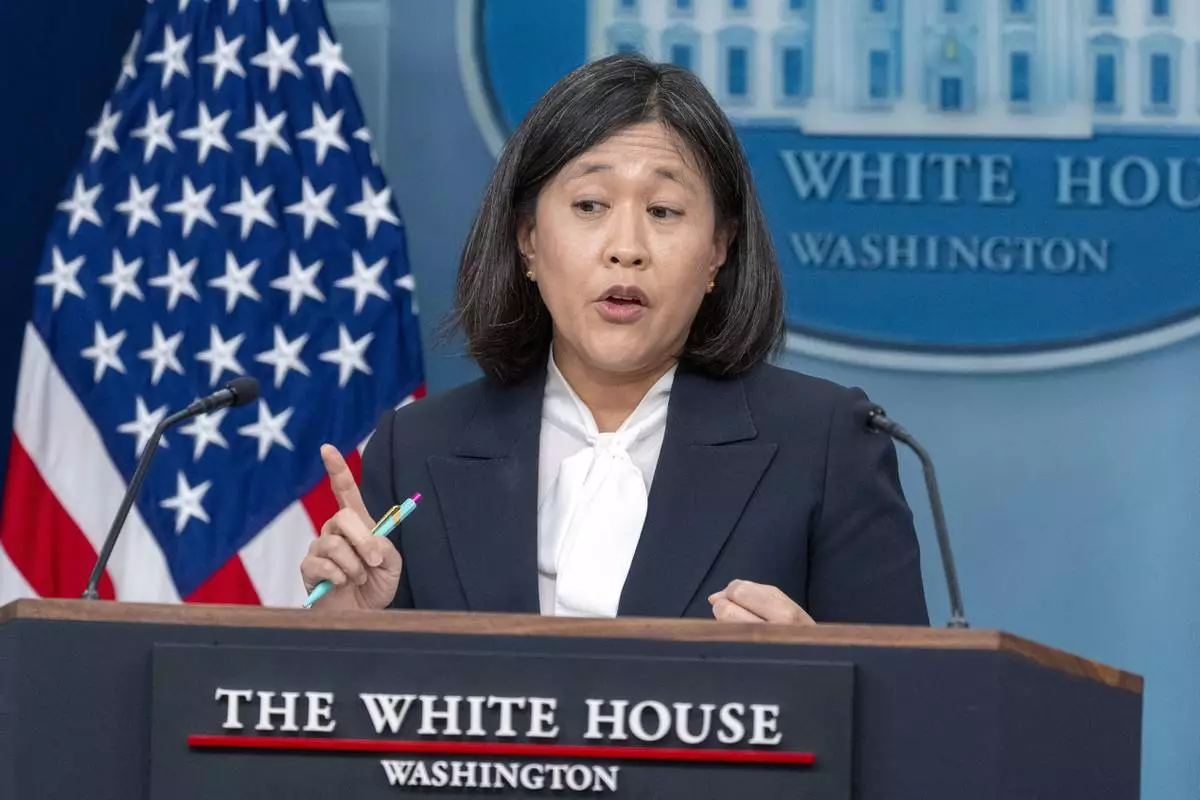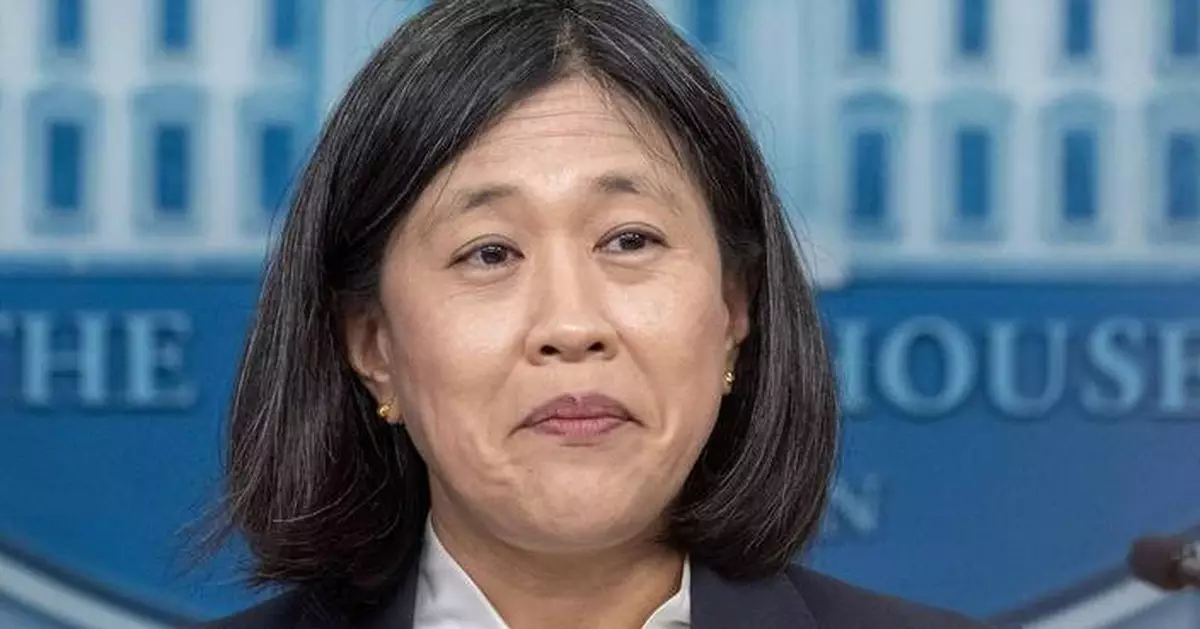WASHINGTON (AP) — As the U.S. trade representative, Katherine Tai is legally required to avoid discussing the presidential election. But her ideas about fair trade are on the ballot in November.
Voters are essentially being asked to decide whether it is best to work with the rest of the world or threaten it. Do they favor pursuing worker protections in trade talks, as Tai has done on behalf of the Biden-Harris administration? Or should the United States jack up taxes on almost everything it imports as Donald Trump has pledged to do?
After nearly four years in her job, Tai feels she is making progress on getting the U.S. and its trade partners to focus more on workers’ rights. Decades of trade deals often prioritized keeping costs low by finding cheap labor that could, in some cases, be exploited.
“You can’t do trade policy by yourself,” Tai said in an interview with The Associated Press. “I am confident that the path that we are on is the right path to be on. I think the only question is how much progress we are able to make in these next years.”
It is an approach that has drawn criticism from business leaders, economists and Republicans who say that the U.S. has not made enough progress on new trade partnerships and countering China's rise.
“There have been no trade deals, no talks to expand free trade agreements,” Rep. Carol Miller, R-W.Va., said in an April congressional hearing with Tai. “Compared to China’s ambitious agenda, the United States is falling behind in every region in the world.”
Trump says that broad tariffs of at least 20% on all imports -– and possibly even higher on some products from China and Mexico -– would bring back American factory jobs. Most economists say they would hurt economic growth and raise inflation, though the former president has dismissed those concerns.
“If you’re a foreign country and you don’t make your product here, then you will have to pay a tariff, a fairly substantial one, which will go into our treasury, will reduce taxes,” Trump, the Republican presidential nominee this year, said at a recent rally in Erie, Pennsylvania.
Tai has degrees from Yale University and Harvard Law School, but strives for a blue-collar perspective on trade. She said that she has injected once-excluded labor union voices into the trade process.
The Biden-Harris administration has not rejected tariffs. It kept the ones on China from Trump's presidency. It has imposed a 100% tariff on Chinese electric vehicles, even though there is not much of a U.S. market for these vehicles that can cost, without tariffs, as little as $12,000. Tai sees that as a way to shield an emerging industry against subsidized and unfair competition.
But the administration also is looking to bolster U.S. workers in the face of competition from China through other industrial policies, such as funding for computer chip factories and tax breaks for technology in renewable energy sources.
The reality, according to some economists, is that domestic factories did not simply lose jobs to China. There were productivity gains that meant some manufacturers needed fewer employers and there was a broader shift as more workers moved away from manufacturing and into the services sector. Those factors often get less emphasis from Tai, said Mary Lovely, a senior fellow at the Peterson Institute for International Economics.
“It seems to me that she’s focusing on the easy one — the one where you can blame the ’bad guy,’ China,” Lovely said.
There is unfinished work.
The trade pillar of the Indo-Pacific Economic Framework spearheaded by Tai remains incomplete. That effort by Washington and its allies in Asia is meant to counterbalance China’s ascendance without needing a trade deal, but it puts more of a focus on workers' rights and environmental protections than past proposals.
“What I have discovered is that we actually all want the same thing,” Tai said. “Fundamentally, what we’re doing is innovating the way you do trade policy, innovating the way globalization is going to play out into the future.”
Tai said she is trying to foster a trade policy with other countries that “allows for us to build our middle class together and to stop pitting them against each other, because that’s been the model we’ve been pursuing for the last several decades.”
William Reinsch at the Center for Strategic and International Studies said it is not surprising that Asian countries involved in the initiative would say they support their middle-class workers. But he saidt Democrats have not provided the access to U.S. markets that trade partners want in return for the focus on workers.
“The consistent message we have gotten from the Asian partners is that they are looking for tangible benefits, and the U.S. is not providing any,” he said. “Trying to rearrange the traditional social order, however meritorious that would be, can be an uphill battle.”
Tai sees herself as having a proof of concept that her approach to trade can thrive. It just happens to come from the U.S.-Mexico-Canada Agreement, the revised North American trade deal signed during the Trump administration and cited by Trump as evidence that he knows how to negotiate with the rest of the world.
In her interview, Tai said the agreement includes a “rapid response mechanism” that enables the government to penalize factories that violate workers’ rights. Tai said that as of late September, the U.S. government has invoked the mechanism 28 times and concluded 25 of those efforts.
Tai said that has directly benefited 30,000 Mexican workers who could elect their own union representation, allowing them to receive higher wages, back pay and other benefits.
“We are empowering workers through trade,” she said. “And by empowering Mexico’s workers, we are ensuring that America’s workers do not have to compete with workers in our neighboring country who are being exploited and who are being deprived of rights.”
Praise for the agreement appears to be a rare point of convergence on trade between Trump and the Biden-Harris administration. But their perspectives are different. Trump tells voters that his threats of massive tariffs can cause foreign governments to accept America's terms on trade and immigration.
“I ended NAFTA, the worst trade deal ever made and replaced it with the USMCA, the best trade deal ever made," he said Monday, referring to the North America Free Trade Agreement signed by Democratic President Bill Clinton.
Tai, barred by the federal Hatch Act from weighing in on the presidential campaign from her office, is cautious in her remarks. But she disputes Trump's claim.
She notes that there were actually two negotiations on trade with Canada and Mexico. The first negotiation was among the Trump administration and the other two nations. But the second was between Trump’s team and congressional Democrats who needed to ratify the deal and that led to worker protections, a component Tai worked on when she was a congressional staffer.
But then, she added, just getting a written deal on trade protections and rights is never enough. The text needs to be backed up by action.
“They’re just words on the page unless it’s implemented,” she said.

FILE - U.S. Trade Representative Katherine Tai speaks with reporters in the James Brady Press Briefing Room at the White House, May 14, 2024, in Washington. (AP Photo/Alex Brandon, File)

FILE - U.S. Trade Representative Katherine Tai speaks during a media briefing at the State Department, Sept. 29, 2023, in Washington. (AP Photo/Mark Schiefelbein, File)

FILE - U.S. Trade Representative Katherine Tai speaks with reporters in the James Brady Press Briefing Room at the White House, May 14, 2024, in Washington. (AP Photo/Alex Brandon, File)













